
Centaurea is a genus of over 700 species of herbaceous thistle-like flowering plants in the family Asteraceae. Members of the genus are found only north of the equator, mostly in the Eastern Hemisphere; the Middle East and surrounding regions are particularly species-rich. In the western United States, yellow starthistles are an invasive species. Around the year 1850, seeds from the plant had arrived to the state of California. It is believed that those seeds came from South America.

Centaurea cyanus, commonly known as cornflower or bachelor's button, is an annual flowering plant in the family Asteraceae native to Europe. In the past, it often grew as a weed in cornfields, hence its name. It is now endangered in its native habitat by agricultural intensification, particularly by over-use of herbicides. However, Centaurea cyanus is now also naturalised in many other parts of the world, including North America and parts of Australia through introduction as an ornamental plant in gardens and as a seed contaminant in crop seeds.

Centaurea scabiosa, or greater knapweed, is a perennial plant of the genus Centaurea. It is native to Europe and bears purple flower heads.
Skullcap or skull cap usually refers to various types of headgear. Specifically it may refer to:
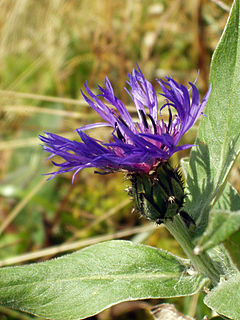
Centaurea montana, the perennial cornflower, mountain cornflower, bachelor's button, montane knapweed or mountain bluet, is a species of flowering plant in the family Asteraceae, endemic to Europe. It is widespread and common in the more southerly mountain ranges of Europe, but is rarer in the north. It escapes from gardens readily, and has thereby become established in the British Isles, Scandinavia and North America. This plant has become an invasive species in British Columbia, Canada.
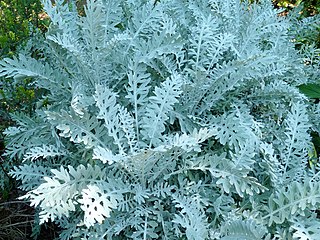
Centaurea cineraria, the velvet centaurea, is – like some other plants – also known as dusty miller and silver dust. It is a small plant in the family Asteraceae and originates from the Island of Capraia in Italy, where it is called fiordaliso delle scogliere.
Bachelor's buttons is a common name for several plant species:
Dusty Miller may refer to:

Centaurea gymnocarpa, also known as fiordaliso di Capraia (Italian) is a species of flowering plant in the family Asteraceae. It is a rare species endemic to Italy found only on Capraia, a small island located in the Tuscan Archipelago, with the species being distributed across 8 subpopulations on the island's surface. Its natural habitats are Mediterranean-type shrubby vegetation and rocky areas, colonizing in the cracks and fissures of cliffs.
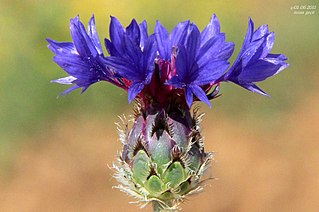
Centaurea depressa, the low cornflower, is a species of Centaurea. It is native to southwestern and central Asia. Its common name is Iranian knapweed. The plant grows to 0.3 m (1 ft) tall and flowers from July to August. It can grow in nutritionally poor soil and is drought tolerant.

Psephellus dealbatus, the Persian cornflower or whitewash cornflower, is a species of Psephellus native to the Caucasus Mountains and Turkey. It is widely cultivated as an ornamental perennial.

The Blue Oak Ranch Reserve, a unit of the University of California Natural Reserve System, is an ecological reserve and biological field station in Santa Clara County, California. It is located on 3,260 acres (13.2 km2) in the Diablo Range, northwest of Mount Hamilton, at 1,500 ft (460 m) elevation.
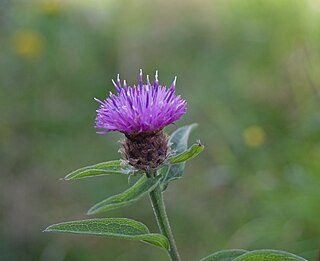
Centaurea nigra is a species of flowering plant in the family Asteraceae known by the common names lesser knapweed, common knapweed and black knapweed. A local vernacular name is hardheads.
B. australis may refer to:

Centaurea stoebe, the spotted knapweed or panicled knapweed, is a species of Centaurea native to eastern Europe, although it has spread to North America, where it is considered an invasive species. It forms a tumbleweed, helping to increase the species' reach, and the seeds are also enabled by a feathery pappus.
Blue-Eyed Mary may refer to:
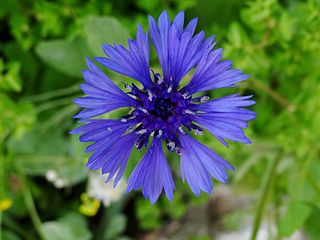
Centaurea cyanoides, the Syrian cornflower, is a species of Centaurea. It is native to Cyprus, Israel, Jordan, Lebanon, and Syria.
This page is based on this
Wikipedia article Text is available under the
CC BY-SA 4.0 license; additional terms may apply.
Images, videos and audio are available under their respective licenses.











